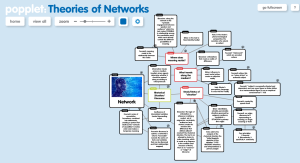I realized that I am off on my Mind Map updates. I thought they were for the NEXT week’s work, not the previous one’s. I thought I had to do the new reading before updating. So last week’s more comprehensive updates were really both Foucaults. The Bazerman and Miller and Popham and the Digital Writing Assessment stuff are for AFTER this week’s class. Sometimes I’m a little slow on the uptake.
So this week I spent time cleaning up my Popplett and attempting to reorganize it. I made two color schemes, corresponding to structuralism and deconstruction, aligning Biesecker and Foucault together, and Bitzer and Vatz together (and the genre folks will end up here, I suspect). Red for deconstruction (it bleeds …. it hurts us) and Blue for structure (it calms us … it gives false sense of unity). I actually deleted several Popples that were no longer needed and some extraneous connections. I also came upon the limitations of the interface. I wanted to create a “super-Popple” which contained other Popples, to show nested categories rather than simple linear connections. My exercise became one of dealing with the limitations rather than freely making connections. I believe that this iteration may prepare me to absorb the next round of theorists, but I suspect my basis for categorization will shift again as the map seeks to encompass more.

